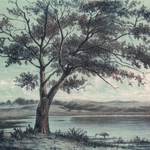Op weg naar een nationaal landschap: botanische wandelingen in het 'Album der Natuur' (1861-1909)
DOI:
https://doi.org/10.18352/bmgn-lchr.6524Keywords:
Nature, identityAbstract
Leen Dresen, Towards a national landscape: botanical walks in the journal Album der Natuur (1861-1909)
This article traces developments within the 'botanical walks' that were featured in the successful Dutch popular science journal Album der Natuur, and proposes to interpret these developments as an indication of changing cultural attitudes towards the national landscape in the Netherlands. The first botanical walks in the 1860s were aimed at collecting as many different plants as possible, without paying much attention to any kind of 'national' character of the vegetation. However, during the 1870s and 1880s, identifying the national character of the vegetation became the main focus of the walks. Nationality was seen to express itself in vegetation and in humans, as a native and historical essence of the local climate.
Around 1900, a new generation of authors adopted a new approach by no longer focussing on the historical character of the landscape. Instead, the reader was now taken for imaginary walks along new stereotypes of the Dutch natural landscape, which were formulated in biological and didactic terms: like the forest, the dunes and the polder. This new style of botanical description concurred with the rise of the nature conservation movement in the Netherlands, which displayed the same progress-oriented outlook towards the Dutch natural landscape.
This article is part of the special issue 'Landschap, natuur en nationale identiteit'.
Downloads

Downloads
Published
Issue
Section
License
Authors who publish with this journal agree to the following terms:
a) Authors retain copyright and grant the journal right of first publication with the work simultaneously licensed under a Creative Commons Attribution 4.0 International (CC BY 4.0) that allows others to share the work with an acknowledgement of the work's authorship and initial publication in this journal.
b) Authors are able to enter into separate, additional contractual arrangements for the non-exclusive distribution of the journal's published version of the work (e.g., post it to an institutional repository or publish it in a book), with an acknowledgement of its initial publication in this journal.
c) Authors are permitted to post their work online (e.g., in institutional repositories or on their website) prior to and during the submission process.
Authors are explicitly encouraged to deposit their published article in their institutional repository.







